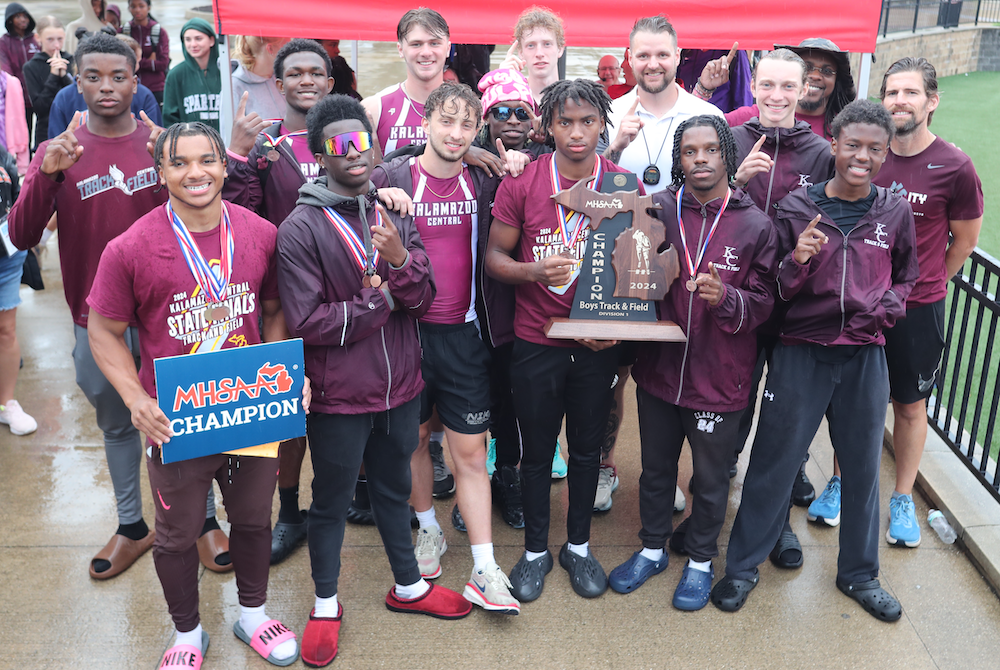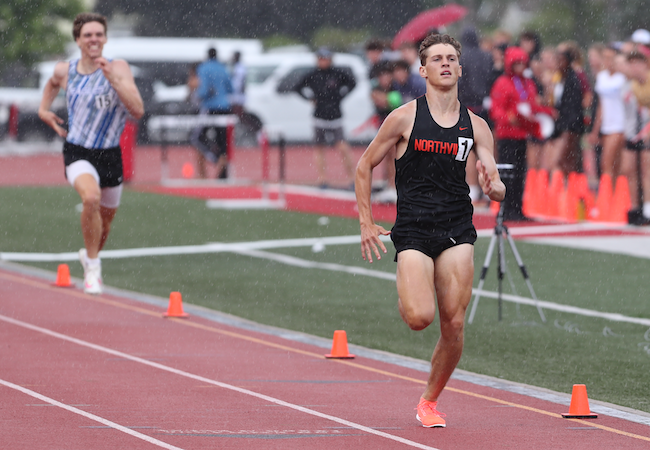
Classes Still Create Hoosier Hysteria
July 27, 2017
By Rob Kaminski
MHSAA benchmarks editor
This is the fourth part in a series on MHSAA tournament classification, past and present, that will be published over the next two weeks. This series originally ran in this spring's edition of MHSAA benchmarks.
Twenty years ago, Bloomington North High School won the Indiana High School Athletic Association boys basketball championship, defeating Delta 75-54 at the RCA Dome in Indianapolis.
The date, March 22, 1997, is at the same time revered and disdained by traditionalists in the state who saw it as the last schoolboy championship game the state would ever host.
That’s how devout the game of basketball, particularly interscholastic basketball, had become in the Hoosier state during the 87 years a state champion – one state champion, to be precise – was crowned.
Following that 1997 season, the IHSAA moved to a four-class system for its roundball tournaments, like so many of its state association counterparts had done years earlier.
It would be shocking to find more than a small percentage of current high school basketball players around the country unfamiliar with the iconic movie Hoosiers, even though the film is now more than 30 years old.
And, the storyline for that blockbuster unfolded more than 30 years prior to its release, when small-town, undermanned Milan High School defeated Muncie Central High School 32-30 in the 1954 IHSAA title game.
Perhaps it’s because of the David vs Goliath notion, or the fame of the movie that replaced Milan with the fictional Hickory and real-life star Bobby Plump with Hollywood hero Jimmy Chitwood, or the simple fact that Indiana had something other states didn’t.
Whatever the reason, plenty of opposition remains to this day to basketball classification in the state.
The fact is, the small rural schools were regularly being beaten handily by the much larger suburban and city schools as the tournament progressed each season.
Small schools also were closing at a rapid rate following the state’s School Reorganization Act in 1959, as students converged on larger, centralized county schools. From 1960 to 2000, the number of schools entering the tournament dropped from 694 to 381, and in 1997 a total of 382 schools and 4,584 athletes began competition at the Sectional level (the first level of the IHSAA Basketball Tournament).
It was at the entry level of the tournament where school administrators felt the pain of the new class system, but not necessarily for the same nostalgic reasons as the fans who either attended or boycotted the tournament.
At the Sectional round of the tournament, the IHSAA was culling just 2 percent of the revenue, with the participating schools splitting the balance. So, when Sectional attendance dropped by 14 percent in that first year of class basketball, many schools realized a financial loss. It was money they had grown to count on in prior years to help fund various aspects of the department.
Schools cumulatively received more than $900,000 from Sectional competition in 1998, but that total was down from more than $1 million in the last year of the single-class tournament.
Yet, the current format provides a great deal more opportunity and realistic chances at championship runs for schools of all enrollments.
To date, 60 additional teams have championship or runner-up trophies on display in school trophy cases around Indiana.
That was the mission in front of then-IHSAA commissioner Bob Gardner (now National Federation executive director) once the board made its decision: to give thousands more student-athletes the opportunity for once-in-a-lifetime experiences.
As any statistician knows, figures can be manipulated to tell any side of a story. Declining attendance in year one of class basketball is such a number.
The truth is tournament attendance had been on a steady downward spiral since its peak of just over 1.5 million in 1962. By the last single-class event in 1997, the total attendance was half that.
The challenge then and today, as it is for all state associations, is to find that delicate balance for those holding onto tradition, those holding onto trophies, and the number of trophies to hand out.
Editor’s Note: Stories from the Fort Wayne Journal Gazette in 1998 and from a 2007 issue of Indianapolis Monthly provided facts in this article.

Kalamazoo Central Headlines LPD1 Finals with 1st Championship since 1965
By
Steve Vedder
Special for MHSAA.com
June 2, 2024
KENTWOOD – Garrett Weeden figures that condensing a four-year dream to a single, all-or-nothing throw is not the easiest way to win a state championship.
But that was the unlikely storyline for Weeden in Saturday's shot put at the MHSAA Lower Peninsula Division 1 Finals at East Kentwood. With one throw left for him in the shot put, the Zeeland East senior was staring at a runner-up finish behind Walled Lake Central leader Tyler Marrogy, whose toss of 58 feet, 2 inches had topped the field.
What's worse is that Weeden freely admits there were past moments during his throwing career when he wouldn't have exactly – well, let's say – risen to the occasion.
All that was rushing through Weeden's mind before he stepped up with a last-ditch throw of 59 feet to win the event. Weeden has been in the hunt for a Finals title in the past, with a ninth place in the shot (and a sixth in the discus) a year ago, but the main prize had always eluded him. That is, until his last throw Saturday.
"I know I needed around a 58-4 and that I had thrown a 59-1 once at an indoor meet," said Weeden, whose previous outdoor best was a 57-7. I wasn't thinking about technique or anything, I just got into it and threw. I just put it all out there.
"I used to be the kind of guy who didn't do well in situations like that. But I've gone to a lot of big meets that have given me confidence. I just knew I needed to step up and do it."
While Weeden's clutch throw was one of the best stories from the individual portion of the meet, Kalamazoo Central narrowly won a wild three-team race for first place. The Maroon Giants finished first with 41 points, just ahead of 39 by Clinton Township Chippewa Valley and 38 by Belleville. Grand Haven was fourth with 29 points, and Ann Arbor Huron had 26.
Kalamazoo Central coach Tyler Germain, whose team won its first Finals title since 1965, said he told his athletes the victory was possible.
"I told them maybe because I knew they could compete," he said. "I told them anything can happen, We just went out and competed; we ran real well. We weren't overconfident or anything, but we have a good, competitive group that I've seen grow up."
 Kalamazoo Central wound up placing in six events, with a first by junior Jeremy Dixon in the 100 (10.72).
Kalamazoo Central wound up placing in six events, with a first by junior Jeremy Dixon in the 100 (10.72).
Four-year senior Latay'vion Braxton admitted that while his teammates listened closely to their coach's prediction, there was at least a trickle of doubt in the runners' minds at the start of the season.
"I don't think I felt like it was really in the plan," he said. "I don't know that we thought it would happen. But some of us grew up together, and we thought maybe this was the time to do it."
Among the most dominating showings in the meet were a pair of firsts in the 200 (21.36) and 400 (46.76) by Chippewa Valley's Shamar Heard. The University of Tennessee-bound Heard finishes an outstanding career with three Finals titles in the 200, two in the 400 and one in the 100. He also helped the 1,600 relay to a first (3:17.51) on Saturday.
"After my breakout year as a sophomore, I knew what I could do," he said. "I quit the 100, but still won as part of a (relay) team. It's been a challenge mentally and physically, but with repetition you learn to trust the process."
Among the other victories was a first place in the pole vault (15-3) by East Kentwood sophomore Reece Emeott, the son of Falcons coach Dave Emeott. Reese said he's been dreaming of a state championship in the pole vault since attending his father's offseason pole vault camp as a middle schooler.
"That's always been the goal; I've been working toward it since I was a little kid," he said. "I was the No. 1 seed, and I've been unbeaten the last couple months so I thought I'd have a chance. I just needed to be consistent. I knew I was good enough. I just had to execute."
Grand Haven senior Seth Norder won the 1,600 (4:03.01). He was the runner-up in that event two years ago and then spent more time in the 3,200 in 2023. Seven of the eight runners in the 1,600 ran personal bests, including Norder.
"I didn't like where my speed was so I worked on it," he said. "I knew this was a good field as the guys who finished second and third will be teammates with me at Michigan State next year. I thought I ran well."
Northville senior Brendan Herger gained a huge measure of satisfaction when he won the 800 (1:50.08). He finished runner-up in the event a year ago when he lagged down the stretch. This year Herger found himself in much the same situation, but lessons learned a year ago led to different results Saturday.
"I thought I had it last year, and it was a big disappointment," said Herger, who will compete in the upcoming New Balance nationals. "But that was only fuel for the fire this year. (Finishing second) actually helped me. This year I closed faster."
Relay winners on Saturday included Holland West Ottawa in the 800 (1:25.53) and 400 (41.35) and Northville in the 3,200 (7:44.52).
Individually, Schmar Gamble of Belleville won the 110 hurdles (13.85), Leonardo Peralta-Castro of Lincoln Park the 300 hurdles (37.93), Thomas Westphal of New Baltimore Anchor Bay the 3,200 (9:07.56), Isaac Quincy of Canton the long jump (23-3¾), Brock Fergison of Sturgis the high jump (6-10) and Clinton Allen of Grosse Pointe North the discus (177-3). Anchor Bay junior Luke Bowman won the adaptive 200, 400 and shot put events, and South Lyon freshman Owen Moerdyke won the adaptive 100 race.
PHOTOS (Top) Kalamazoo Central celebrates its first Finals championship Saturday since 1965. (Middle) Northville’s Brendan Herger pulls away for the win in the 800. (Click for more from John Brabbs/RunMichigan.com.)

